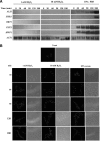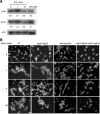A MAP kinase pathway is implicated in the pseudohyphal induction by hydrogen peroxide in Candica albicans
- PMID: 22358510
- PMCID: PMC3887715
- DOI: 10.1007/s10059-012-2244-y
A MAP kinase pathway is implicated in the pseudohyphal induction by hydrogen peroxide in Candica albicans
Abstract
Hydrogen peroxide (H(2)O(2)) functions as a ubiquitous intracellular messenger besides as an oxidative stress molecule. This dual role is based on the distinct cellular responses against different concentrations of H(2)O(2). Previously, we demonstrated that both low (> 1 mM) and high (4-10 mM) doses of exogenous H(2)O(2) induce filamentous growth with distinct cell morphology and growth rate in Candida albicans, suggesting the different transcription response. In this study, we revealed that the sub-toxic and toxic levels of H(2)O(2) indeed induced pseudohyphae, but not true hyphae. Supporting this, several hyphae-specific genes that are expressed in true hyphae induced by serum were not detected in either sub-toxic or toxic H(2)O(2) condition. A DNA microarray analysis was conducted to reveal the transcription profiles in cells treated with sub-toxic and toxic conditions of H(2)O(2). Under the sub-toxic condition, a small number of genes involved in cell proliferation and metabolism were up-regulated, whereas a large number of genes were up-regulated in the toxic condition where the genes required for growth and proliferation were selectively restricted. For pseudohyphal induction by sub-toxic H(2)O(2), Cek1 MAPK activating the transcription factor Cph1 was shown to be important. The absence of expression of several hyphae-specific genes known to be downstream targets of Cph1-signaling pathway for true hyphae formation suggests that the Cek1-mediated signaling pathway is not solely responsible for pseudohyphal formation by subtoxic H(2)O(2) and, but instead, complex networking pathway may exists by the activation of different regulators.
Figures




References
-
- Aguirre J., Rios-Momberg M., Hewitt D., Hansberg W. Reactive oxygen species and development in microbial eukaryotes. Trends Microbiol. 2005;13:111–118. - PubMed
-
- Alonso-Monge R., Roman E., Arana D.M., Prieto D., Urrialde V., Nombela C., Pal J. The Sko1 protein represses the yeast-to-hypha transition and regulates the oxidative stress response in Candida albicans. Fungal Genet. Biol. 2010;47:587–601. - PubMed
-
- Andaluz E., Ciudad T., Gomez-Raja J., Calderone R., Larriba G. Rad52 depletion in Candida albicans triggers both the DNA-damage checkpoint and filamentation accompanied by but independent of expression of hypha-specific genes. Mol. Microbiol. 2006;59:1452–1472. - PubMed
Publication types
MeSH terms
Substances
LinkOut - more resources
Full Text Sources

